Remuneration Management: STAR
VerifiedAdded on 2023/01/12
|12
|2900
|92
AI Summary
This report discusses the current remuneration practices at STAR Industries and provides recommendations for a new remuneration strategy for two positions. It also explores the implications of fringe benefits tax and the process of communicating the new strategy to the organization.
Contribute Materials
Your contribution can guide someone’s learning journey. Share your
documents today.
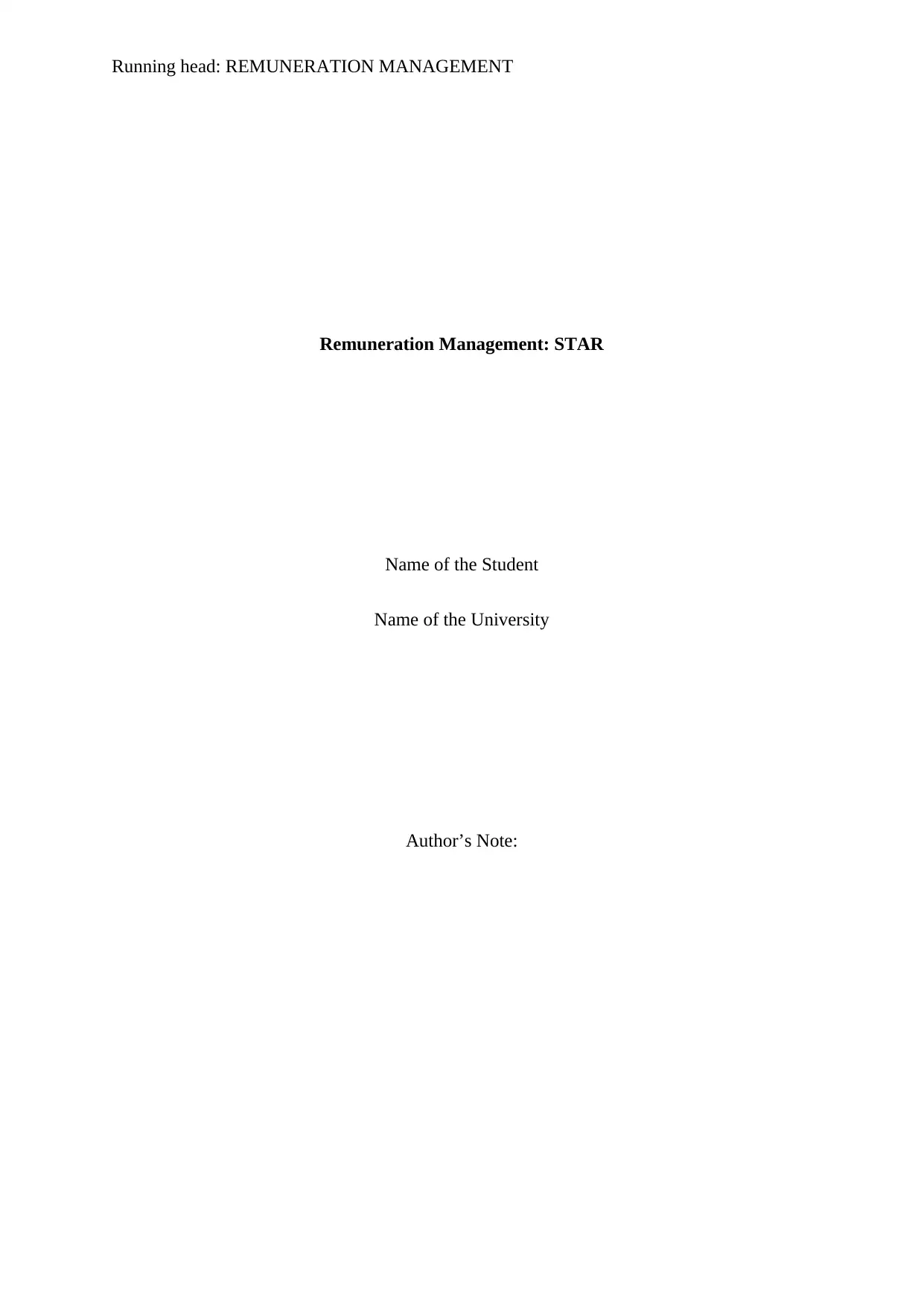
Running head: REMUNERATION MANAGEMENT
Remuneration Management: STAR
Name of the Student
Name of the University
Author’s Note:
Remuneration Management: STAR
Name of the Student
Name of the University
Author’s Note:
Secure Best Marks with AI Grader
Need help grading? Try our AI Grader for instant feedback on your assignments.
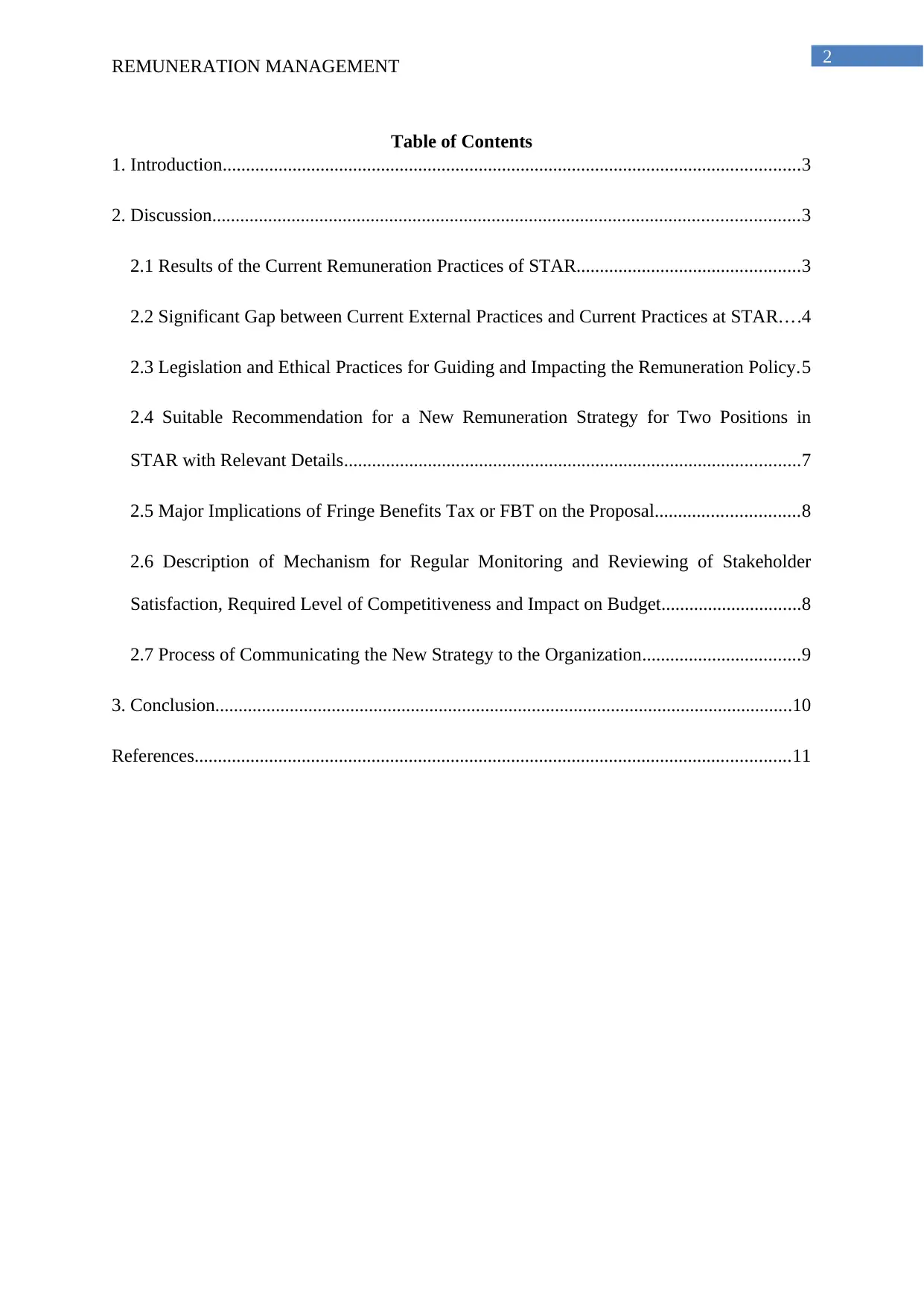
2
REMUNERATION MANAGEMENT
Table of Contents
1. Introduction............................................................................................................................3
2. Discussion..............................................................................................................................3
2.1 Results of the Current Remuneration Practices of STAR................................................3
2.2 Significant Gap between Current External Practices and Current Practices at STAR....4
2.3 Legislation and Ethical Practices for Guiding and Impacting the Remuneration Policy.5
2.4 Suitable Recommendation for a New Remuneration Strategy for Two Positions in
STAR with Relevant Details..................................................................................................7
2.5 Major Implications of Fringe Benefits Tax or FBT on the Proposal...............................8
2.6 Description of Mechanism for Regular Monitoring and Reviewing of Stakeholder
Satisfaction, Required Level of Competitiveness and Impact on Budget..............................8
2.7 Process of Communicating the New Strategy to the Organization..................................9
3. Conclusion............................................................................................................................10
References................................................................................................................................11
REMUNERATION MANAGEMENT
Table of Contents
1. Introduction............................................................................................................................3
2. Discussion..............................................................................................................................3
2.1 Results of the Current Remuneration Practices of STAR................................................3
2.2 Significant Gap between Current External Practices and Current Practices at STAR....4
2.3 Legislation and Ethical Practices for Guiding and Impacting the Remuneration Policy.5
2.4 Suitable Recommendation for a New Remuneration Strategy for Two Positions in
STAR with Relevant Details..................................................................................................7
2.5 Major Implications of Fringe Benefits Tax or FBT on the Proposal...............................8
2.6 Description of Mechanism for Regular Monitoring and Reviewing of Stakeholder
Satisfaction, Required Level of Competitiveness and Impact on Budget..............................8
2.7 Process of Communicating the New Strategy to the Organization..................................9
3. Conclusion............................................................................................................................10
References................................................................................................................................11
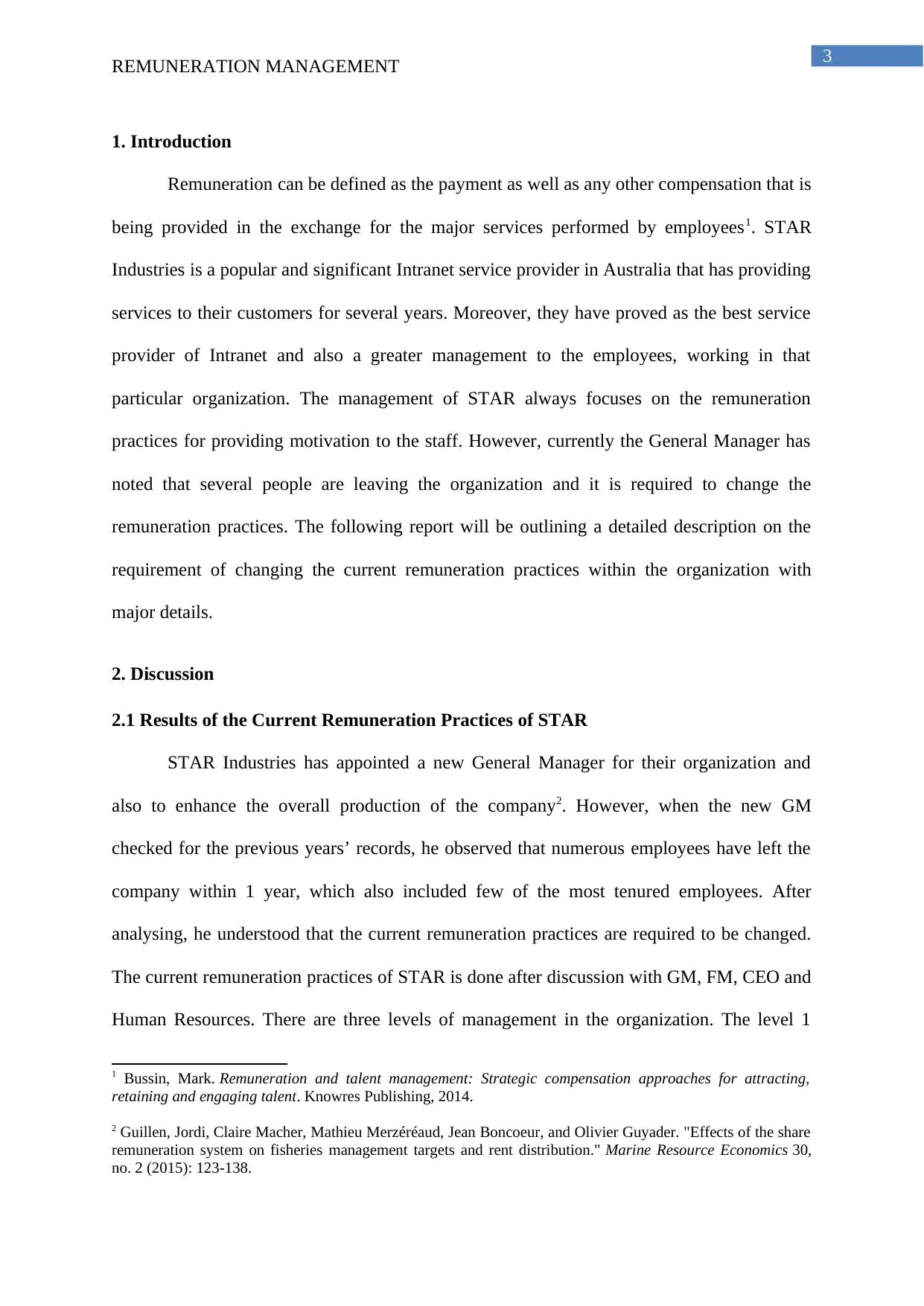
3
REMUNERATION MANAGEMENT
1. Introduction
Remuneration can be defined as the payment as well as any other compensation that is
being provided in the exchange for the major services performed by employees1. STAR
Industries is a popular and significant Intranet service provider in Australia that has providing
services to their customers for several years. Moreover, they have proved as the best service
provider of Intranet and also a greater management to the employees, working in that
particular organization. The management of STAR always focuses on the remuneration
practices for providing motivation to the staff. However, currently the General Manager has
noted that several people are leaving the organization and it is required to change the
remuneration practices. The following report will be outlining a detailed description on the
requirement of changing the current remuneration practices within the organization with
major details.
2. Discussion
2.1 Results of the Current Remuneration Practices of STAR
STAR Industries has appointed a new General Manager for their organization and
also to enhance the overall production of the company2. However, when the new GM
checked for the previous years’ records, he observed that numerous employees have left the
company within 1 year, which also included few of the most tenured employees. After
analysing, he understood that the current remuneration practices are required to be changed.
The current remuneration practices of STAR is done after discussion with GM, FM, CEO and
Human Resources. There are three levels of management in the organization. The level 1
1 Bussin, Mark. Remuneration and talent management: Strategic compensation approaches for attracting,
retaining and engaging talent. Knowres Publishing, 2014.
2 Guillen, Jordi, Claire Macher, Mathieu Merzéréaud, Jean Boncoeur, and Olivier Guyader. "Effects of the share
remuneration system on fisheries management targets and rent distribution." Marine Resource Economics 30,
no. 2 (2015): 123-138.
REMUNERATION MANAGEMENT
1. Introduction
Remuneration can be defined as the payment as well as any other compensation that is
being provided in the exchange for the major services performed by employees1. STAR
Industries is a popular and significant Intranet service provider in Australia that has providing
services to their customers for several years. Moreover, they have proved as the best service
provider of Intranet and also a greater management to the employees, working in that
particular organization. The management of STAR always focuses on the remuneration
practices for providing motivation to the staff. However, currently the General Manager has
noted that several people are leaving the organization and it is required to change the
remuneration practices. The following report will be outlining a detailed description on the
requirement of changing the current remuneration practices within the organization with
major details.
2. Discussion
2.1 Results of the Current Remuneration Practices of STAR
STAR Industries has appointed a new General Manager for their organization and
also to enhance the overall production of the company2. However, when the new GM
checked for the previous years’ records, he observed that numerous employees have left the
company within 1 year, which also included few of the most tenured employees. After
analysing, he understood that the current remuneration practices are required to be changed.
The current remuneration practices of STAR is done after discussion with GM, FM, CEO and
Human Resources. There are three levels of management in the organization. The level 1
1 Bussin, Mark. Remuneration and talent management: Strategic compensation approaches for attracting,
retaining and engaging talent. Knowres Publishing, 2014.
2 Guillen, Jordi, Claire Macher, Mathieu Merzéréaud, Jean Boncoeur, and Olivier Guyader. "Effects of the share
remuneration system on fisheries management targets and rent distribution." Marine Resource Economics 30,
no. 2 (2015): 123-138.
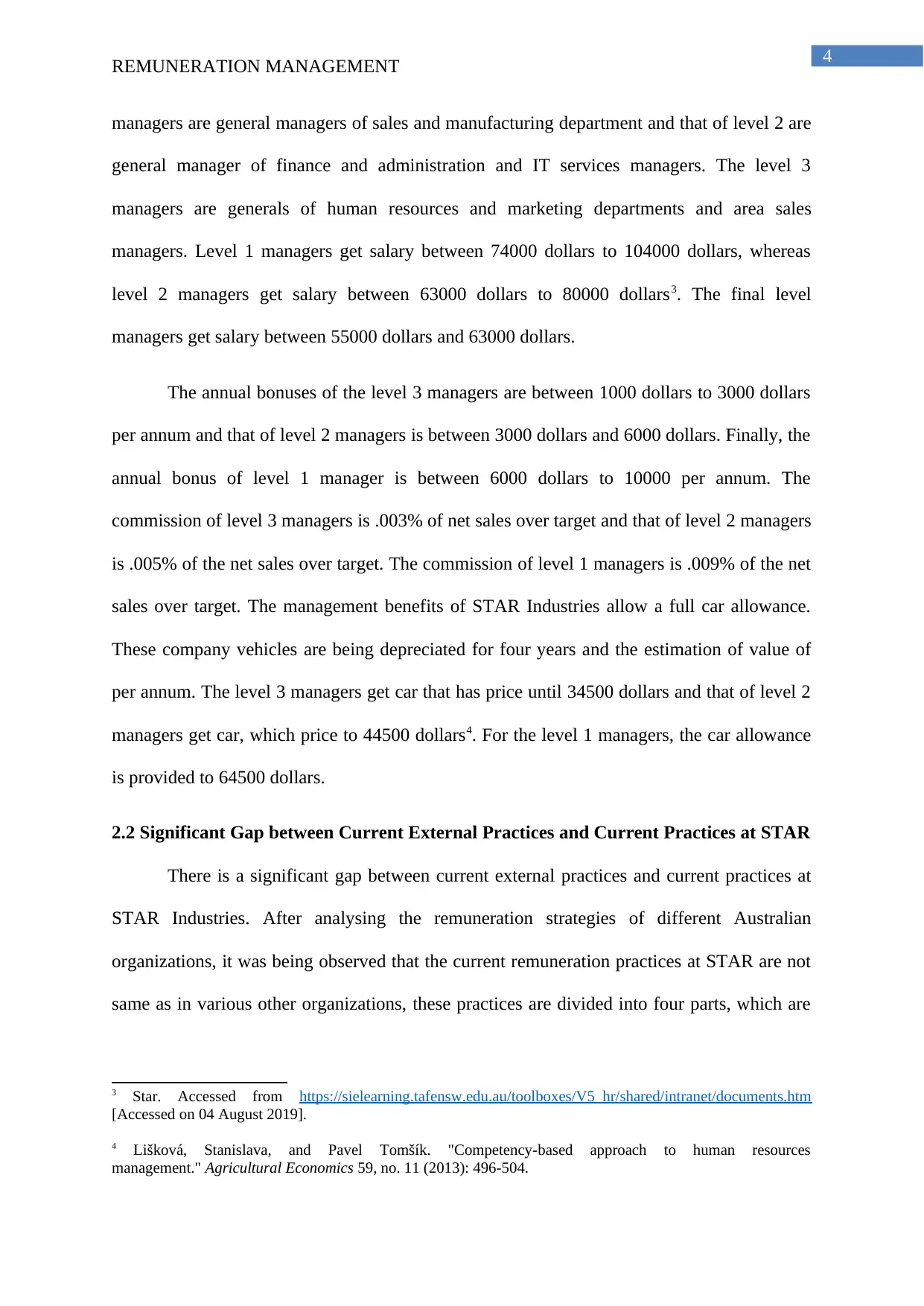
4
REMUNERATION MANAGEMENT
managers are general managers of sales and manufacturing department and that of level 2 are
general manager of finance and administration and IT services managers. The level 3
managers are generals of human resources and marketing departments and area sales
managers. Level 1 managers get salary between 74000 dollars to 104000 dollars, whereas
level 2 managers get salary between 63000 dollars to 80000 dollars3. The final level
managers get salary between 55000 dollars and 63000 dollars.
The annual bonuses of the level 3 managers are between 1000 dollars to 3000 dollars
per annum and that of level 2 managers is between 3000 dollars and 6000 dollars. Finally, the
annual bonus of level 1 manager is between 6000 dollars to 10000 per annum. The
commission of level 3 managers is .003% of net sales over target and that of level 2 managers
is .005% of the net sales over target. The commission of level 1 managers is .009% of the net
sales over target. The management benefits of STAR Industries allow a full car allowance.
These company vehicles are being depreciated for four years and the estimation of value of
per annum. The level 3 managers get car that has price until 34500 dollars and that of level 2
managers get car, which price to 44500 dollars4. For the level 1 managers, the car allowance
is provided to 64500 dollars.
2.2 Significant Gap between Current External Practices and Current Practices at STAR
There is a significant gap between current external practices and current practices at
STAR Industries. After analysing the remuneration strategies of different Australian
organizations, it was being observed that the current remuneration practices at STAR are not
same as in various other organizations, these practices are divided into four parts, which are
3 Star. Accessed from https://sielearning.tafensw.edu.au/toolboxes/V5_hr/shared/intranet/documents.htm
[Accessed on 04 August 2019].
4 Lišková, Stanislava, and Pavel Tomšík. "Competency-based approach to human resources
management." Agricultural Economics 59, no. 11 (2013): 496-504.
REMUNERATION MANAGEMENT
managers are general managers of sales and manufacturing department and that of level 2 are
general manager of finance and administration and IT services managers. The level 3
managers are generals of human resources and marketing departments and area sales
managers. Level 1 managers get salary between 74000 dollars to 104000 dollars, whereas
level 2 managers get salary between 63000 dollars to 80000 dollars3. The final level
managers get salary between 55000 dollars and 63000 dollars.
The annual bonuses of the level 3 managers are between 1000 dollars to 3000 dollars
per annum and that of level 2 managers is between 3000 dollars and 6000 dollars. Finally, the
annual bonus of level 1 manager is between 6000 dollars to 10000 per annum. The
commission of level 3 managers is .003% of net sales over target and that of level 2 managers
is .005% of the net sales over target. The commission of level 1 managers is .009% of the net
sales over target. The management benefits of STAR Industries allow a full car allowance.
These company vehicles are being depreciated for four years and the estimation of value of
per annum. The level 3 managers get car that has price until 34500 dollars and that of level 2
managers get car, which price to 44500 dollars4. For the level 1 managers, the car allowance
is provided to 64500 dollars.
2.2 Significant Gap between Current External Practices and Current Practices at STAR
There is a significant gap between current external practices and current practices at
STAR Industries. After analysing the remuneration strategies of different Australian
organizations, it was being observed that the current remuneration practices at STAR are not
same as in various other organizations, these practices are divided into four parts, which are
3 Star. Accessed from https://sielearning.tafensw.edu.au/toolboxes/V5_hr/shared/intranet/documents.htm
[Accessed on 04 August 2019].
4 Lišková, Stanislava, and Pavel Tomšík. "Competency-based approach to human resources
management." Agricultural Economics 59, no. 11 (2013): 496-504.
Secure Best Marks with AI Grader
Need help grading? Try our AI Grader for instant feedback on your assignments.
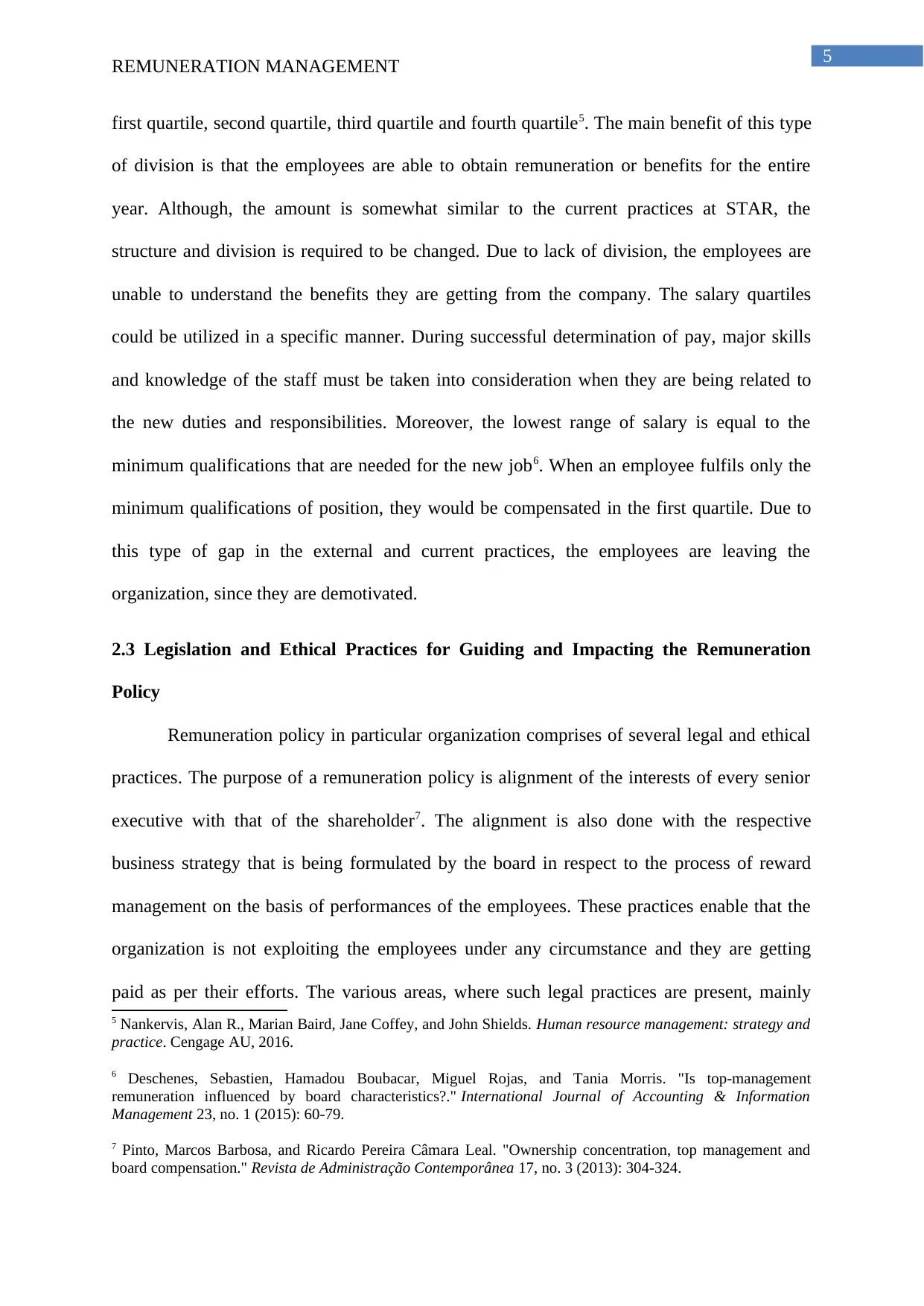
5
REMUNERATION MANAGEMENT
first quartile, second quartile, third quartile and fourth quartile5. The main benefit of this type
of division is that the employees are able to obtain remuneration or benefits for the entire
year. Although, the amount is somewhat similar to the current practices at STAR, the
structure and division is required to be changed. Due to lack of division, the employees are
unable to understand the benefits they are getting from the company. The salary quartiles
could be utilized in a specific manner. During successful determination of pay, major skills
and knowledge of the staff must be taken into consideration when they are being related to
the new duties and responsibilities. Moreover, the lowest range of salary is equal to the
minimum qualifications that are needed for the new job6. When an employee fulfils only the
minimum qualifications of position, they would be compensated in the first quartile. Due to
this type of gap in the external and current practices, the employees are leaving the
organization, since they are demotivated.
2.3 Legislation and Ethical Practices for Guiding and Impacting the Remuneration
Policy
Remuneration policy in particular organization comprises of several legal and ethical
practices. The purpose of a remuneration policy is alignment of the interests of every senior
executive with that of the shareholder7. The alignment is also done with the respective
business strategy that is being formulated by the board in respect to the process of reward
management on the basis of performances of the employees. These practices enable that the
organization is not exploiting the employees under any circumstance and they are getting
paid as per their efforts. The various areas, where such legal practices are present, mainly
5 Nankervis, Alan R., Marian Baird, Jane Coffey, and John Shields. Human resource management: strategy and
practice. Cengage AU, 2016.
6 Deschenes, Sebastien, Hamadou Boubacar, Miguel Rojas, and Tania Morris. "Is top-management
remuneration influenced by board characteristics?." International Journal of Accounting & Information
Management 23, no. 1 (2015): 60-79.
7 Pinto, Marcos Barbosa, and Ricardo Pereira Câmara Leal. "Ownership concentration, top management and
board compensation." Revista de Administração Contemporânea 17, no. 3 (2013): 304-324.
REMUNERATION MANAGEMENT
first quartile, second quartile, third quartile and fourth quartile5. The main benefit of this type
of division is that the employees are able to obtain remuneration or benefits for the entire
year. Although, the amount is somewhat similar to the current practices at STAR, the
structure and division is required to be changed. Due to lack of division, the employees are
unable to understand the benefits they are getting from the company. The salary quartiles
could be utilized in a specific manner. During successful determination of pay, major skills
and knowledge of the staff must be taken into consideration when they are being related to
the new duties and responsibilities. Moreover, the lowest range of salary is equal to the
minimum qualifications that are needed for the new job6. When an employee fulfils only the
minimum qualifications of position, they would be compensated in the first quartile. Due to
this type of gap in the external and current practices, the employees are leaving the
organization, since they are demotivated.
2.3 Legislation and Ethical Practices for Guiding and Impacting the Remuneration
Policy
Remuneration policy in particular organization comprises of several legal and ethical
practices. The purpose of a remuneration policy is alignment of the interests of every senior
executive with that of the shareholder7. The alignment is also done with the respective
business strategy that is being formulated by the board in respect to the process of reward
management on the basis of performances of the employees. These practices enable that the
organization is not exploiting the employees under any circumstance and they are getting
paid as per their efforts. The various areas, where such legal practices are present, mainly
5 Nankervis, Alan R., Marian Baird, Jane Coffey, and John Shields. Human resource management: strategy and
practice. Cengage AU, 2016.
6 Deschenes, Sebastien, Hamadou Boubacar, Miguel Rojas, and Tania Morris. "Is top-management
remuneration influenced by board characteristics?." International Journal of Accounting & Information
Management 23, no. 1 (2015): 60-79.
7 Pinto, Marcos Barbosa, and Ricardo Pereira Câmara Leal. "Ownership concentration, top management and
board compensation." Revista de Administração Contemporânea 17, no. 3 (2013): 304-324.
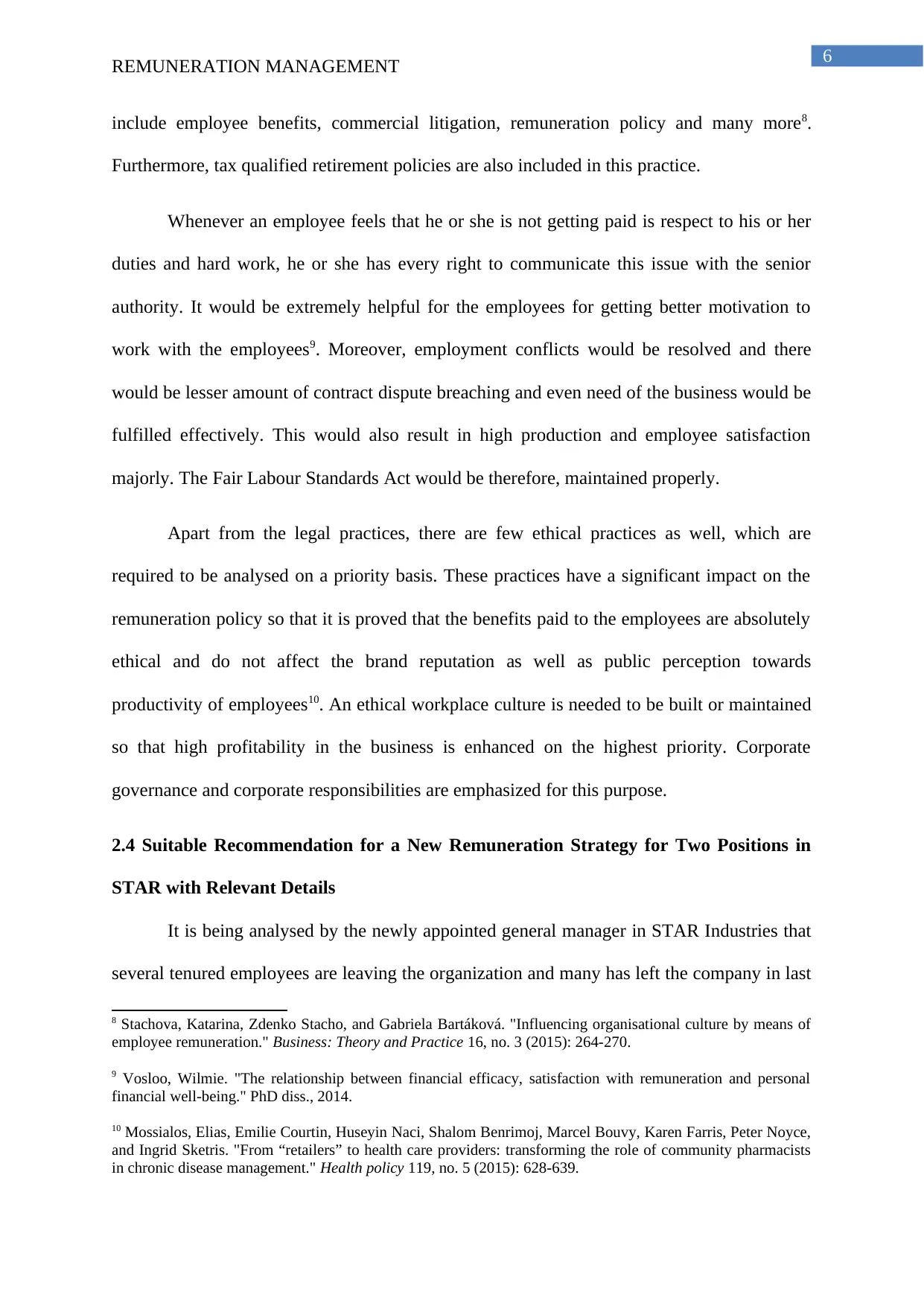
6
REMUNERATION MANAGEMENT
include employee benefits, commercial litigation, remuneration policy and many more8.
Furthermore, tax qualified retirement policies are also included in this practice.
Whenever an employee feels that he or she is not getting paid is respect to his or her
duties and hard work, he or she has every right to communicate this issue with the senior
authority. It would be extremely helpful for the employees for getting better motivation to
work with the employees9. Moreover, employment conflicts would be resolved and there
would be lesser amount of contract dispute breaching and even need of the business would be
fulfilled effectively. This would also result in high production and employee satisfaction
majorly. The Fair Labour Standards Act would be therefore, maintained properly.
Apart from the legal practices, there are few ethical practices as well, which are
required to be analysed on a priority basis. These practices have a significant impact on the
remuneration policy so that it is proved that the benefits paid to the employees are absolutely
ethical and do not affect the brand reputation as well as public perception towards
productivity of employees10. An ethical workplace culture is needed to be built or maintained
so that high profitability in the business is enhanced on the highest priority. Corporate
governance and corporate responsibilities are emphasized for this purpose.
2.4 Suitable Recommendation for a New Remuneration Strategy for Two Positions in
STAR with Relevant Details
It is being analysed by the newly appointed general manager in STAR Industries that
several tenured employees are leaving the organization and many has left the company in last
8 Stachova, Katarina, Zdenko Stacho, and Gabriela Bartáková. "Influencing organisational culture by means of
employee remuneration." Business: Theory and Practice 16, no. 3 (2015): 264-270.
9 Vosloo, Wilmie. "The relationship between financial efficacy, satisfaction with remuneration and personal
financial well-being." PhD diss., 2014.
10 Mossialos, Elias, Emilie Courtin, Huseyin Naci, Shalom Benrimoj, Marcel Bouvy, Karen Farris, Peter Noyce,
and Ingrid Sketris. "From “retailers” to health care providers: transforming the role of community pharmacists
in chronic disease management." Health policy 119, no. 5 (2015): 628-639.
REMUNERATION MANAGEMENT
include employee benefits, commercial litigation, remuneration policy and many more8.
Furthermore, tax qualified retirement policies are also included in this practice.
Whenever an employee feels that he or she is not getting paid is respect to his or her
duties and hard work, he or she has every right to communicate this issue with the senior
authority. It would be extremely helpful for the employees for getting better motivation to
work with the employees9. Moreover, employment conflicts would be resolved and there
would be lesser amount of contract dispute breaching and even need of the business would be
fulfilled effectively. This would also result in high production and employee satisfaction
majorly. The Fair Labour Standards Act would be therefore, maintained properly.
Apart from the legal practices, there are few ethical practices as well, which are
required to be analysed on a priority basis. These practices have a significant impact on the
remuneration policy so that it is proved that the benefits paid to the employees are absolutely
ethical and do not affect the brand reputation as well as public perception towards
productivity of employees10. An ethical workplace culture is needed to be built or maintained
so that high profitability in the business is enhanced on the highest priority. Corporate
governance and corporate responsibilities are emphasized for this purpose.
2.4 Suitable Recommendation for a New Remuneration Strategy for Two Positions in
STAR with Relevant Details
It is being analysed by the newly appointed general manager in STAR Industries that
several tenured employees are leaving the organization and many has left the company in last
8 Stachova, Katarina, Zdenko Stacho, and Gabriela Bartáková. "Influencing organisational culture by means of
employee remuneration." Business: Theory and Practice 16, no. 3 (2015): 264-270.
9 Vosloo, Wilmie. "The relationship between financial efficacy, satisfaction with remuneration and personal
financial well-being." PhD diss., 2014.
10 Mossialos, Elias, Emilie Courtin, Huseyin Naci, Shalom Benrimoj, Marcel Bouvy, Karen Farris, Peter Noyce,
and Ingrid Sketris. "From “retailers” to health care providers: transforming the role of community pharmacists
in chronic disease management." Health policy 119, no. 5 (2015): 628-639.
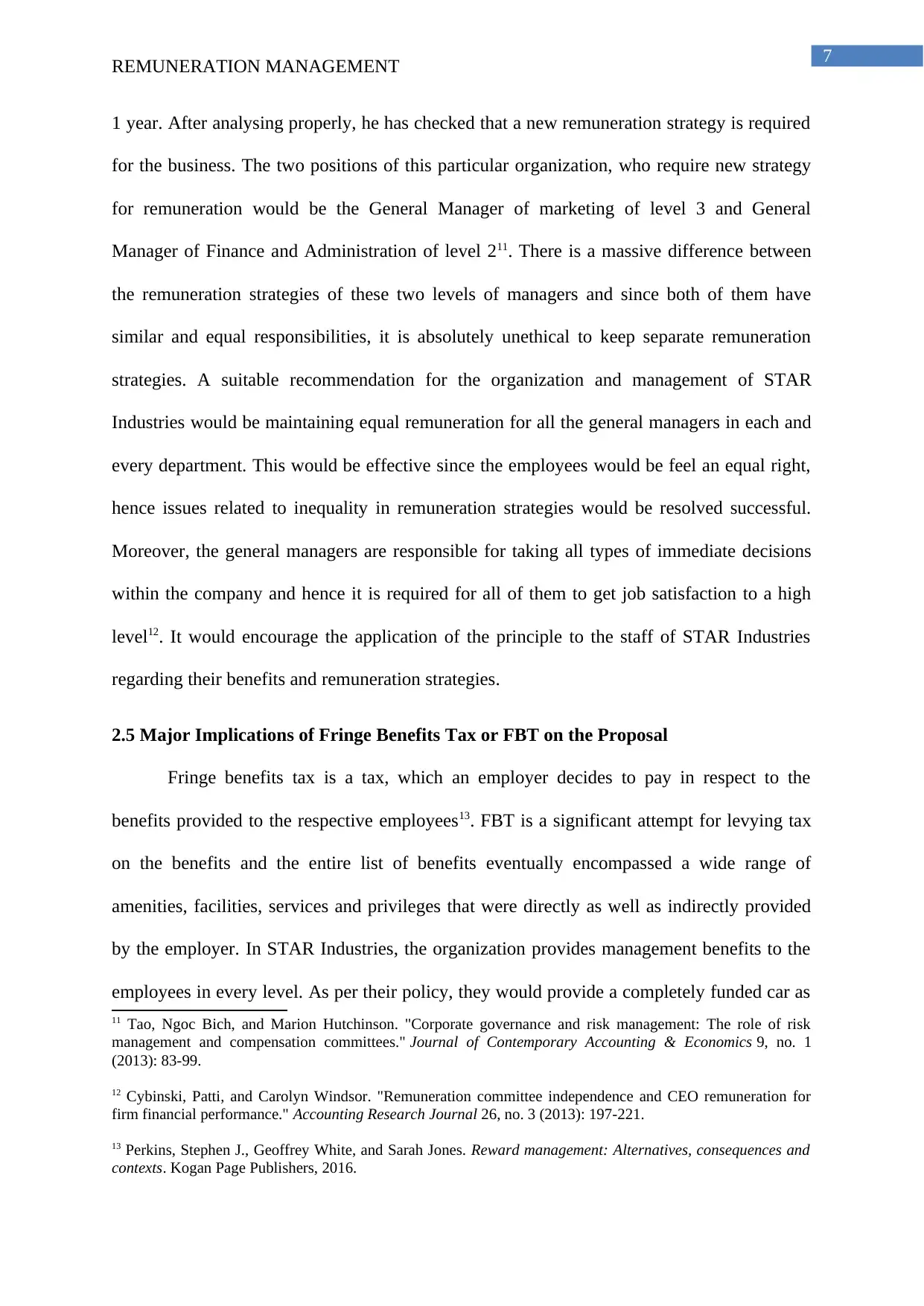
7
REMUNERATION MANAGEMENT
1 year. After analysing properly, he has checked that a new remuneration strategy is required
for the business. The two positions of this particular organization, who require new strategy
for remuneration would be the General Manager of marketing of level 3 and General
Manager of Finance and Administration of level 211. There is a massive difference between
the remuneration strategies of these two levels of managers and since both of them have
similar and equal responsibilities, it is absolutely unethical to keep separate remuneration
strategies. A suitable recommendation for the organization and management of STAR
Industries would be maintaining equal remuneration for all the general managers in each and
every department. This would be effective since the employees would be feel an equal right,
hence issues related to inequality in remuneration strategies would be resolved successful.
Moreover, the general managers are responsible for taking all types of immediate decisions
within the company and hence it is required for all of them to get job satisfaction to a high
level12. It would encourage the application of the principle to the staff of STAR Industries
regarding their benefits and remuneration strategies.
2.5 Major Implications of Fringe Benefits Tax or FBT on the Proposal
Fringe benefits tax is a tax, which an employer decides to pay in respect to the
benefits provided to the respective employees13. FBT is a significant attempt for levying tax
on the benefits and the entire list of benefits eventually encompassed a wide range of
amenities, facilities, services and privileges that were directly as well as indirectly provided
by the employer. In STAR Industries, the organization provides management benefits to the
employees in every level. As per their policy, they would provide a completely funded car as
11 Tao, Ngoc Bich, and Marion Hutchinson. "Corporate governance and risk management: The role of risk
management and compensation committees." Journal of Contemporary Accounting & Economics 9, no. 1
(2013): 83-99.
12 Cybinski, Patti, and Carolyn Windsor. "Remuneration committee independence and CEO remuneration for
firm financial performance." Accounting Research Journal 26, no. 3 (2013): 197-221.
13 Perkins, Stephen J., Geoffrey White, and Sarah Jones. Reward management: Alternatives, consequences and
contexts. Kogan Page Publishers, 2016.
REMUNERATION MANAGEMENT
1 year. After analysing properly, he has checked that a new remuneration strategy is required
for the business. The two positions of this particular organization, who require new strategy
for remuneration would be the General Manager of marketing of level 3 and General
Manager of Finance and Administration of level 211. There is a massive difference between
the remuneration strategies of these two levels of managers and since both of them have
similar and equal responsibilities, it is absolutely unethical to keep separate remuneration
strategies. A suitable recommendation for the organization and management of STAR
Industries would be maintaining equal remuneration for all the general managers in each and
every department. This would be effective since the employees would be feel an equal right,
hence issues related to inequality in remuneration strategies would be resolved successful.
Moreover, the general managers are responsible for taking all types of immediate decisions
within the company and hence it is required for all of them to get job satisfaction to a high
level12. It would encourage the application of the principle to the staff of STAR Industries
regarding their benefits and remuneration strategies.
2.5 Major Implications of Fringe Benefits Tax or FBT on the Proposal
Fringe benefits tax is a tax, which an employer decides to pay in respect to the
benefits provided to the respective employees13. FBT is a significant attempt for levying tax
on the benefits and the entire list of benefits eventually encompassed a wide range of
amenities, facilities, services and privileges that were directly as well as indirectly provided
by the employer. In STAR Industries, the organization provides management benefits to the
employees in every level. As per their policy, they would provide a completely funded car as
11 Tao, Ngoc Bich, and Marion Hutchinson. "Corporate governance and risk management: The role of risk
management and compensation committees." Journal of Contemporary Accounting & Economics 9, no. 1
(2013): 83-99.
12 Cybinski, Patti, and Carolyn Windsor. "Remuneration committee independence and CEO remuneration for
firm financial performance." Accounting Research Journal 26, no. 3 (2013): 197-221.
13 Perkins, Stephen J., Geoffrey White, and Sarah Jones. Reward management: Alternatives, consequences and
contexts. Kogan Page Publishers, 2016.
Paraphrase This Document
Need a fresh take? Get an instant paraphrase of this document with our AI Paraphraser

8
REMUNERATION MANAGEMENT
well as car allowance to the employees, however the car would remain a property of the
company. These allowances are being annually reviewed by the general manager of finance
and administration department14. The company vehicles are being eventually deprecated more
four years and are usually replaced after every 2 years. The subsequent calculation of this
value per annum of any car majorly varies after depending on the list of prices of that specific
vehicle. As per the policies of STAR Industries, FBT can be applicable to every employee,
who is receiving the benefits and in present situation, this particular tax is being evaluated at
48.5 cents in dollar. The management of STAR has agreed to pay off the FBT on behalf of
every employee who would be receiving the car allowance. The new strategy of remuneration
would also enhance to the process of FBT and every employee would be highly satisfied.
2.6 Description of Mechanism for Regular Monitoring and Reviewing of Stakeholder
Satisfaction, Required Level of Competitiveness and Impact on Budget
Stakeholder satisfaction can be referred to be as a major measurement of
stakeholders’ perceptions of an initiative, project and program15. The new recommended
remuneration strategy would enhance regular monitoring and reviewing of stakeholder
satisfaction. It would even focus on the required level of competitiveness as well as have
major impact on the budget. The main reason for it is that employees would be satisfied.
Regular meetings with the employees would be an effective mechanism for such activity.
Since, remuneration is the summation of every non financial as well as financial
compensation, received by any particular staff, it is referred to as the most basic need for the
employees and it is the right of every staff to receive remuneration annually or once in six
months16. Although, different countries have different laws regarding remuneration and
14 Geiler, Philipp, and Luc Renneboog. "Executive remuneration and the payout decision." Corporate
Governance: An International Review 24, no. 1 (2016): 42-63.
15 Bryson, Alex, Bernd Frick, and Rob Simmons. "The returns to scarce talent: Footedness and player
remuneration in European soccer." Journal of Sports Economics 14, no. 6 (2013): 606-628.
16 Fayol, Henri. General and industrial management. Ravenio Books, 2016.
REMUNERATION MANAGEMENT
well as car allowance to the employees, however the car would remain a property of the
company. These allowances are being annually reviewed by the general manager of finance
and administration department14. The company vehicles are being eventually deprecated more
four years and are usually replaced after every 2 years. The subsequent calculation of this
value per annum of any car majorly varies after depending on the list of prices of that specific
vehicle. As per the policies of STAR Industries, FBT can be applicable to every employee,
who is receiving the benefits and in present situation, this particular tax is being evaluated at
48.5 cents in dollar. The management of STAR has agreed to pay off the FBT on behalf of
every employee who would be receiving the car allowance. The new strategy of remuneration
would also enhance to the process of FBT and every employee would be highly satisfied.
2.6 Description of Mechanism for Regular Monitoring and Reviewing of Stakeholder
Satisfaction, Required Level of Competitiveness and Impact on Budget
Stakeholder satisfaction can be referred to be as a major measurement of
stakeholders’ perceptions of an initiative, project and program15. The new recommended
remuneration strategy would enhance regular monitoring and reviewing of stakeholder
satisfaction. It would even focus on the required level of competitiveness as well as have
major impact on the budget. The main reason for it is that employees would be satisfied.
Regular meetings with the employees would be an effective mechanism for such activity.
Since, remuneration is the summation of every non financial as well as financial
compensation, received by any particular staff, it is referred to as the most basic need for the
employees and it is the right of every staff to receive remuneration annually or once in six
months16. Although, different countries have different laws regarding remuneration and
14 Geiler, Philipp, and Luc Renneboog. "Executive remuneration and the payout decision." Corporate
Governance: An International Review 24, no. 1 (2016): 42-63.
15 Bryson, Alex, Bernd Frick, and Rob Simmons. "The returns to scarce talent: Footedness and player
remuneration in European soccer." Journal of Sports Economics 14, no. 6 (2013): 606-628.
16 Fayol, Henri. General and industrial management. Ravenio Books, 2016.

9
REMUNERATION MANAGEMENT
employee payment, it is being noted that all the organizations have their unique remuneration
strategies for the employees. Both the existing and new employees get the opportunity to gain
benefits from this particular strategy.
2.7 Process of Communicating the New Strategy to the Organization
There are numerous complementary advantages as an extra for payment. These are
highly incrementing for each and every organization and is also termed as one of the major
components of reward management. Several distinctive types of remuneration are present,
which are commission, executive compensation, employee benefits, compensation
methodologies, employee stock ownership, salaries with inclusion of performance associated
incentives and finally wages. Remuneration is extremely important for successful
employment that is being provided in the form of payment, salaries as well as wages with
major inclusiveness of allowances, cash incentives, and monetary valuations for non cash
incentive as well as benefits of pension plan or medical plan and finally annual bonuses17.
Thus, it is required to communicate with the employees. The GM of STAR Industries should
organize an open meeting with the employees so that the employees are able to understand
the important and benefit of the new remuneration strategy.
3. Conclusion
Therefore, conclusion can be drawn that remuneration is extremely important and
significant for bringing changes and enhancing employee motivation as well as performances
to a high level. STAR Industries is a major and famous organization that provides Intranet
services to the customers and several employees have working with them. However, recently
several tenured employees have resigned and the main reason for this type of issue is the
17 Mio, Chiara, Andrea Venturelli, and Rossella Leopizzi. "Management by objectives and corporate social
responsibility disclosure: First results from Italy." Accounting, Auditing & Accountability Journal 28, no. 3
(2015): 325-364.
REMUNERATION MANAGEMENT
employee payment, it is being noted that all the organizations have their unique remuneration
strategies for the employees. Both the existing and new employees get the opportunity to gain
benefits from this particular strategy.
2.7 Process of Communicating the New Strategy to the Organization
There are numerous complementary advantages as an extra for payment. These are
highly incrementing for each and every organization and is also termed as one of the major
components of reward management. Several distinctive types of remuneration are present,
which are commission, executive compensation, employee benefits, compensation
methodologies, employee stock ownership, salaries with inclusion of performance associated
incentives and finally wages. Remuneration is extremely important for successful
employment that is being provided in the form of payment, salaries as well as wages with
major inclusiveness of allowances, cash incentives, and monetary valuations for non cash
incentive as well as benefits of pension plan or medical plan and finally annual bonuses17.
Thus, it is required to communicate with the employees. The GM of STAR Industries should
organize an open meeting with the employees so that the employees are able to understand
the important and benefit of the new remuneration strategy.
3. Conclusion
Therefore, conclusion can be drawn that remuneration is extremely important and
significant for bringing changes and enhancing employee motivation as well as performances
to a high level. STAR Industries is a major and famous organization that provides Intranet
services to the customers and several employees have working with them. However, recently
several tenured employees have resigned and the main reason for this type of issue is the
17 Mio, Chiara, Andrea Venturelli, and Rossella Leopizzi. "Management by objectives and corporate social
responsibility disclosure: First results from Italy." Accounting, Auditing & Accountability Journal 28, no. 3
(2015): 325-364.
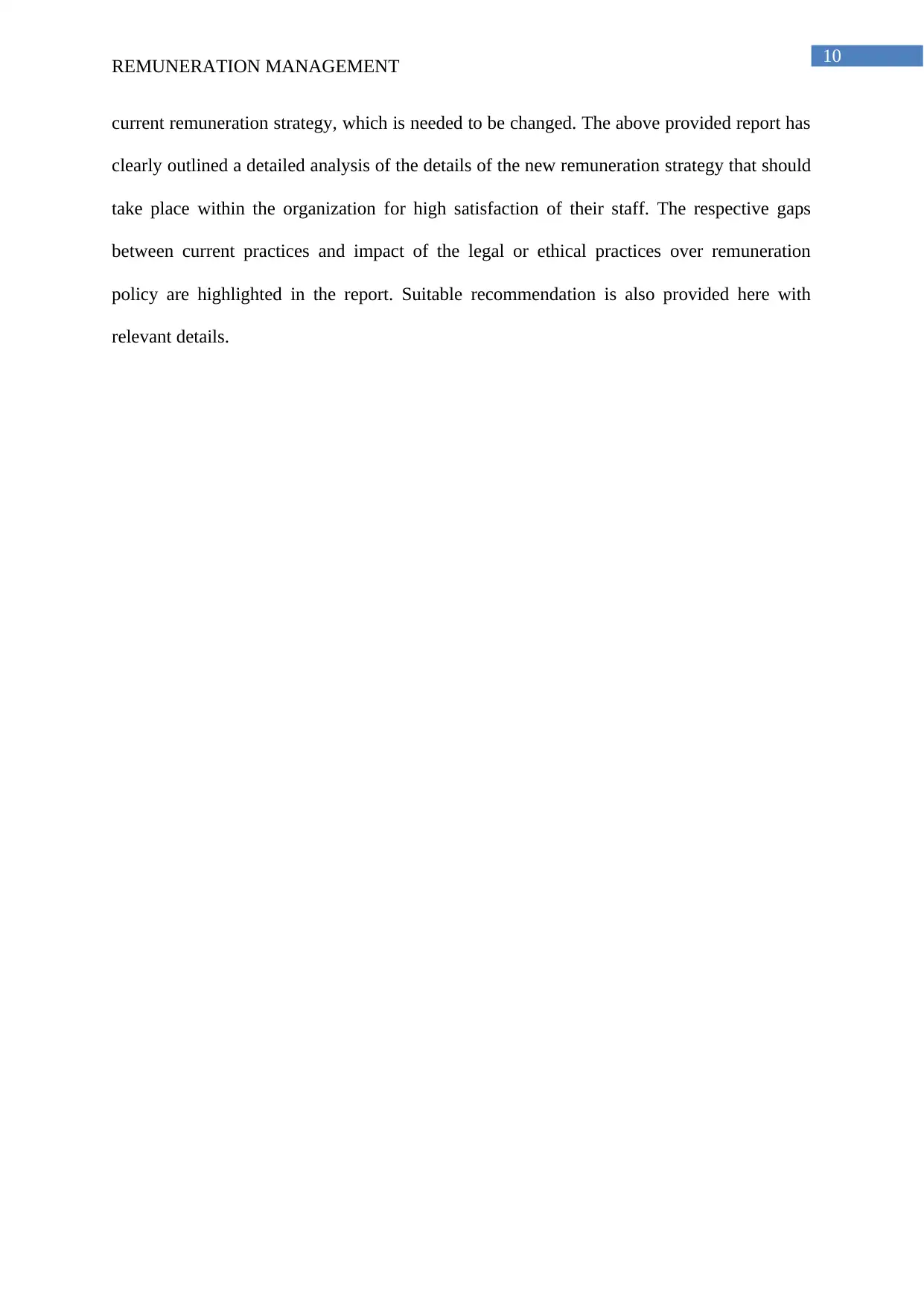
10
REMUNERATION MANAGEMENT
current remuneration strategy, which is needed to be changed. The above provided report has
clearly outlined a detailed analysis of the details of the new remuneration strategy that should
take place within the organization for high satisfaction of their staff. The respective gaps
between current practices and impact of the legal or ethical practices over remuneration
policy are highlighted in the report. Suitable recommendation is also provided here with
relevant details.
REMUNERATION MANAGEMENT
current remuneration strategy, which is needed to be changed. The above provided report has
clearly outlined a detailed analysis of the details of the new remuneration strategy that should
take place within the organization for high satisfaction of their staff. The respective gaps
between current practices and impact of the legal or ethical practices over remuneration
policy are highlighted in the report. Suitable recommendation is also provided here with
relevant details.
Secure Best Marks with AI Grader
Need help grading? Try our AI Grader for instant feedback on your assignments.
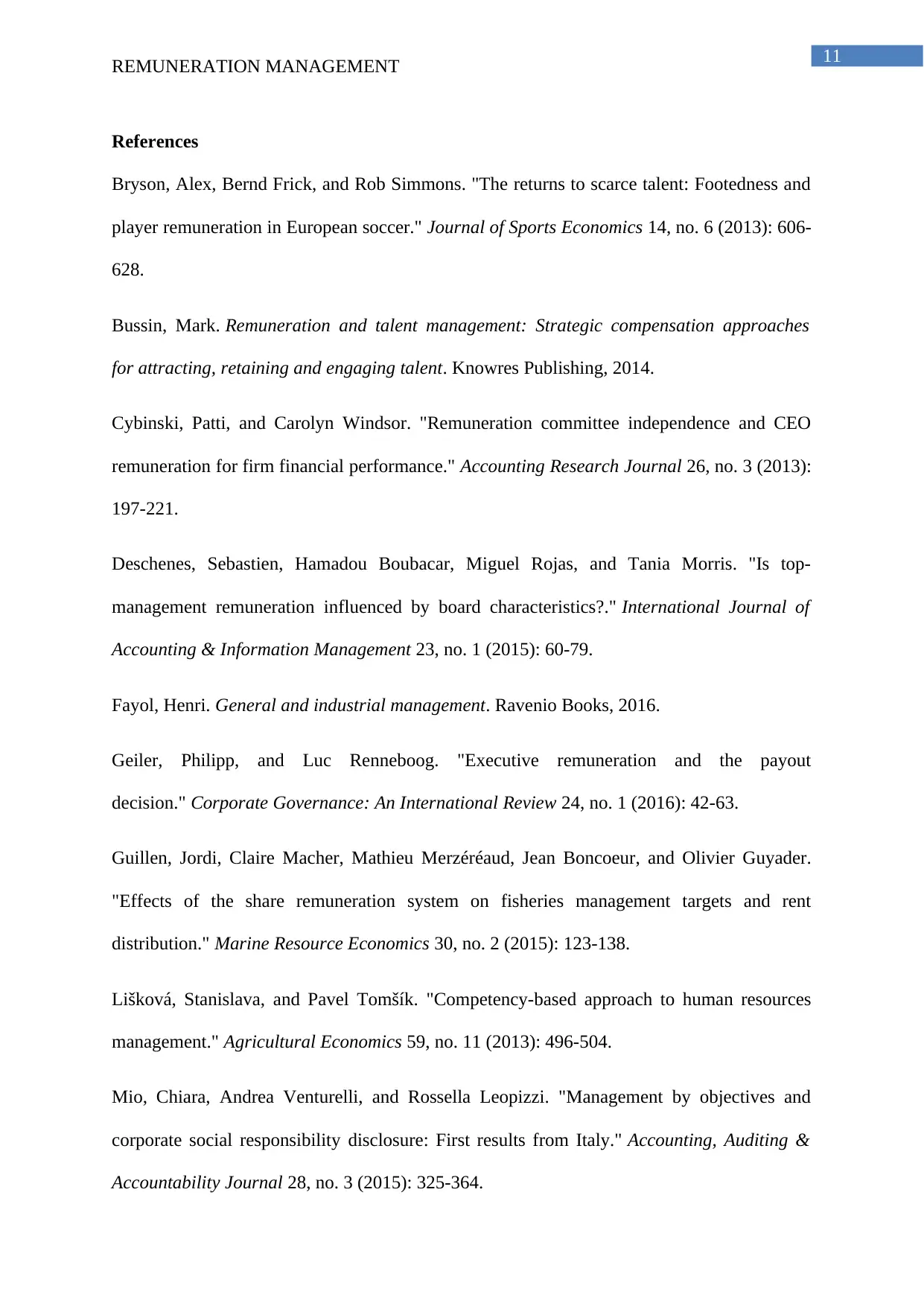
11
REMUNERATION MANAGEMENT
References
Bryson, Alex, Bernd Frick, and Rob Simmons. "The returns to scarce talent: Footedness and
player remuneration in European soccer." Journal of Sports Economics 14, no. 6 (2013): 606-
628.
Bussin, Mark. Remuneration and talent management: Strategic compensation approaches
for attracting, retaining and engaging talent. Knowres Publishing, 2014.
Cybinski, Patti, and Carolyn Windsor. "Remuneration committee independence and CEO
remuneration for firm financial performance." Accounting Research Journal 26, no. 3 (2013):
197-221.
Deschenes, Sebastien, Hamadou Boubacar, Miguel Rojas, and Tania Morris. "Is top-
management remuneration influenced by board characteristics?." International Journal of
Accounting & Information Management 23, no. 1 (2015): 60-79.
Fayol, Henri. General and industrial management. Ravenio Books, 2016.
Geiler, Philipp, and Luc Renneboog. "Executive remuneration and the payout
decision." Corporate Governance: An International Review 24, no. 1 (2016): 42-63.
Guillen, Jordi, Claire Macher, Mathieu Merzéréaud, Jean Boncoeur, and Olivier Guyader.
"Effects of the share remuneration system on fisheries management targets and rent
distribution." Marine Resource Economics 30, no. 2 (2015): 123-138.
Lišková, Stanislava, and Pavel Tomšík. "Competency-based approach to human resources
management." Agricultural Economics 59, no. 11 (2013): 496-504.
Mio, Chiara, Andrea Venturelli, and Rossella Leopizzi. "Management by objectives and
corporate social responsibility disclosure: First results from Italy." Accounting, Auditing &
Accountability Journal 28, no. 3 (2015): 325-364.
REMUNERATION MANAGEMENT
References
Bryson, Alex, Bernd Frick, and Rob Simmons. "The returns to scarce talent: Footedness and
player remuneration in European soccer." Journal of Sports Economics 14, no. 6 (2013): 606-
628.
Bussin, Mark. Remuneration and talent management: Strategic compensation approaches
for attracting, retaining and engaging talent. Knowres Publishing, 2014.
Cybinski, Patti, and Carolyn Windsor. "Remuneration committee independence and CEO
remuneration for firm financial performance." Accounting Research Journal 26, no. 3 (2013):
197-221.
Deschenes, Sebastien, Hamadou Boubacar, Miguel Rojas, and Tania Morris. "Is top-
management remuneration influenced by board characteristics?." International Journal of
Accounting & Information Management 23, no. 1 (2015): 60-79.
Fayol, Henri. General and industrial management. Ravenio Books, 2016.
Geiler, Philipp, and Luc Renneboog. "Executive remuneration and the payout
decision." Corporate Governance: An International Review 24, no. 1 (2016): 42-63.
Guillen, Jordi, Claire Macher, Mathieu Merzéréaud, Jean Boncoeur, and Olivier Guyader.
"Effects of the share remuneration system on fisheries management targets and rent
distribution." Marine Resource Economics 30, no. 2 (2015): 123-138.
Lišková, Stanislava, and Pavel Tomšík. "Competency-based approach to human resources
management." Agricultural Economics 59, no. 11 (2013): 496-504.
Mio, Chiara, Andrea Venturelli, and Rossella Leopizzi. "Management by objectives and
corporate social responsibility disclosure: First results from Italy." Accounting, Auditing &
Accountability Journal 28, no. 3 (2015): 325-364.
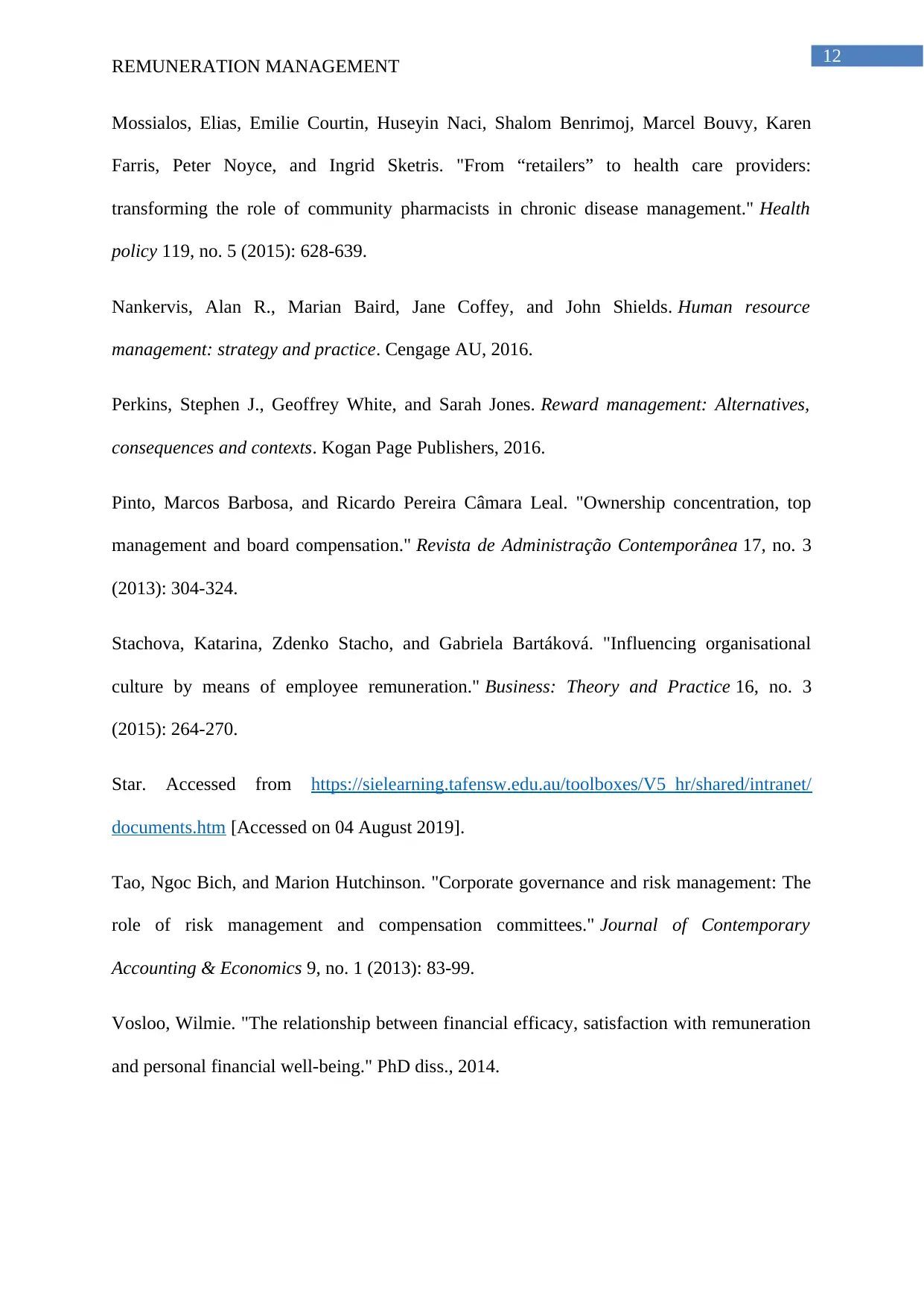
12
REMUNERATION MANAGEMENT
Mossialos, Elias, Emilie Courtin, Huseyin Naci, Shalom Benrimoj, Marcel Bouvy, Karen
Farris, Peter Noyce, and Ingrid Sketris. "From “retailers” to health care providers:
transforming the role of community pharmacists in chronic disease management." Health
policy 119, no. 5 (2015): 628-639.
Nankervis, Alan R., Marian Baird, Jane Coffey, and John Shields. Human resource
management: strategy and practice. Cengage AU, 2016.
Perkins, Stephen J., Geoffrey White, and Sarah Jones. Reward management: Alternatives,
consequences and contexts. Kogan Page Publishers, 2016.
Pinto, Marcos Barbosa, and Ricardo Pereira Câmara Leal. "Ownership concentration, top
management and board compensation." Revista de Administração Contemporânea 17, no. 3
(2013): 304-324.
Stachova, Katarina, Zdenko Stacho, and Gabriela Bartáková. "Influencing organisational
culture by means of employee remuneration." Business: Theory and Practice 16, no. 3
(2015): 264-270.
Star. Accessed from https://sielearning.tafensw.edu.au/toolboxes/V5_hr/shared/intranet/
documents.htm [Accessed on 04 August 2019].
Tao, Ngoc Bich, and Marion Hutchinson. "Corporate governance and risk management: The
role of risk management and compensation committees." Journal of Contemporary
Accounting & Economics 9, no. 1 (2013): 83-99.
Vosloo, Wilmie. "The relationship between financial efficacy, satisfaction with remuneration
and personal financial well-being." PhD diss., 2014.
REMUNERATION MANAGEMENT
Mossialos, Elias, Emilie Courtin, Huseyin Naci, Shalom Benrimoj, Marcel Bouvy, Karen
Farris, Peter Noyce, and Ingrid Sketris. "From “retailers” to health care providers:
transforming the role of community pharmacists in chronic disease management." Health
policy 119, no. 5 (2015): 628-639.
Nankervis, Alan R., Marian Baird, Jane Coffey, and John Shields. Human resource
management: strategy and practice. Cengage AU, 2016.
Perkins, Stephen J., Geoffrey White, and Sarah Jones. Reward management: Alternatives,
consequences and contexts. Kogan Page Publishers, 2016.
Pinto, Marcos Barbosa, and Ricardo Pereira Câmara Leal. "Ownership concentration, top
management and board compensation." Revista de Administração Contemporânea 17, no. 3
(2013): 304-324.
Stachova, Katarina, Zdenko Stacho, and Gabriela Bartáková. "Influencing organisational
culture by means of employee remuneration." Business: Theory and Practice 16, no. 3
(2015): 264-270.
Star. Accessed from https://sielearning.tafensw.edu.au/toolboxes/V5_hr/shared/intranet/
documents.htm [Accessed on 04 August 2019].
Tao, Ngoc Bich, and Marion Hutchinson. "Corporate governance and risk management: The
role of risk management and compensation committees." Journal of Contemporary
Accounting & Economics 9, no. 1 (2013): 83-99.
Vosloo, Wilmie. "The relationship between financial efficacy, satisfaction with remuneration
and personal financial well-being." PhD diss., 2014.
1 out of 12
Related Documents
Your All-in-One AI-Powered Toolkit for Academic Success.
+13062052269
info@desklib.com
Available 24*7 on WhatsApp / Email
![[object Object]](/_next/static/media/star-bottom.7253800d.svg)
Unlock your academic potential
© 2024 | Zucol Services PVT LTD | All rights reserved.





